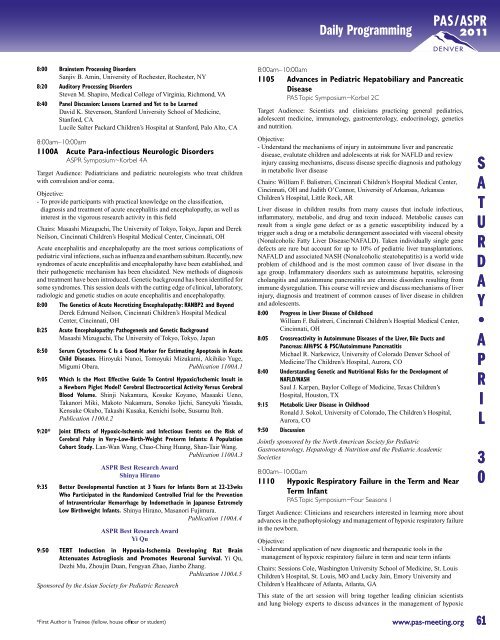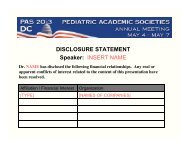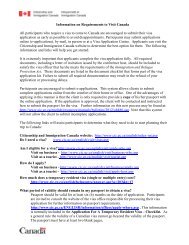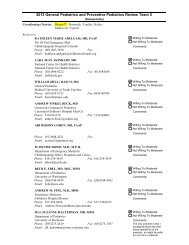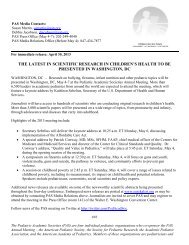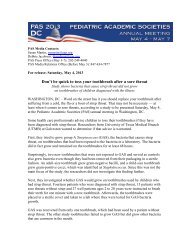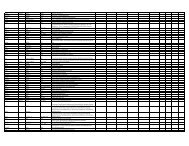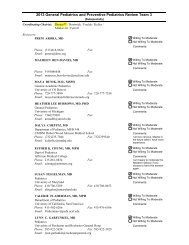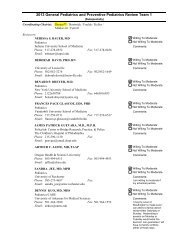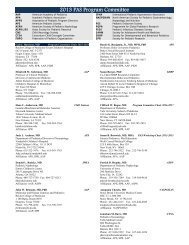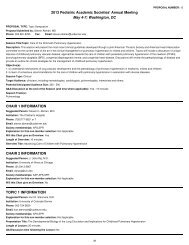F R I D A Y • A P R I L - Pediatric Academic Societies
F R I D A Y • A P R I L - Pediatric Academic Societies
F R I D A Y • A P R I L - Pediatric Academic Societies
Create successful ePaper yourself
Turn your PDF publications into a flip-book with our unique Google optimized e-Paper software.
8:00 Brainstem Processing Disorders<br />
Sanjiv B. Amin, University of Rochester, Rochester, NY<br />
8:20 Auditory Processing Disorders<br />
Steven M. Shapiro, Medical College of Virginia, Richmond, VA<br />
8:40 Panel Discussion: Lessons Learned and Yet to be Learned<br />
David K. Stevenson, Stanford University School of Medicine,<br />
Stanford, CA<br />
Lucile Salter Packard Children’s Hospital at Stanford, Palo Alto, CA<br />
8:00am–10:00am<br />
1100A Acute Para-infectious Neurologic Disorders<br />
ASPR Symposium~Korbel 4A<br />
Target Audience: <strong>Pediatric</strong>ians and pediatric neurologists who treat children<br />
with convulsion and/or coma.<br />
Objective:<br />
- To provide participants with practical knowledge on the classification,<br />
diagnosis and treatment of acute encephalitis and encephalopathy, as well as<br />
interest in the vigorous research activity in this field<br />
Chairs: Masashi Mizuguchi, The University of Tokyo, Tokyo, Japan and Derek<br />
Neilson, Cincinnati Children’s Hospital Medical Center, Cincinnati, OH<br />
Acute encephalitis and encephalopathy are the most serious complications of<br />
pediatric viral infections, such as influenza and exanthem subitum. Recently, new<br />
syndromes of acute encephalitis and encephalopathy have been established, and<br />
their pathogenetic mechanism has been elucidated. New methods of diagnosis<br />
and treatment have been introduced. Genetic background has been identified for<br />
some syndromes. This session deals with the cutting edge of clinical, laboratory,<br />
radiologic and genetic studies on acute encephalitis and encephalopathy.<br />
8:00 The Genetics of Acute Necrotizing Encephalopathy: RANBP2 and Beyond<br />
Derek Edmund Neilson, Cincinnati Children’s Hospital Medical<br />
Center, Cincinnati, OH<br />
8:25 Acute Encephalopathy: Pathogenesis and Genetic Background<br />
Masashi Mizuguchi, The University of Tokyo, Tokyo, Japan<br />
8:50 Serum Cytochrome C Is a Good Marker for Estimating Apoptosis in Acute<br />
Child Diseases. Hiroyuki Nunoi, Tomoyuki Mizukami, Akihiko Yuge,<br />
Migumi Obara. Publication 1100A.1<br />
9:05 Which Is the Most Effective Guide To Control Hypoxic/Ischemic Insult in<br />
a Newborn Piglet Model? Cerebral Electrocortical Activity Versus Cerebral<br />
Blood Volume. Shinji Nakamura, Kosuke Koyano, Masaaki Ueno,<br />
Takanori Miki, Makoto Nakamura, Sonoko Ijichi, Saneyuki Yasuda,<br />
Kensuke Okubo, Takashi Kusaka, Kenichi Isobe, Susumu Itoh.<br />
Publication 1100A.2<br />
9:20* Joint Effects of Hypoxic-Ischemic and Infectious Events on the Risk of<br />
Cerebral Palsy in Very-Low-Birth-Weight Preterm Infants: A Population<br />
Cohort Study. Lan-Wan Wang, Chao-Ching Huang, Shan-Tair Wang.<br />
Publication 1100A.3<br />
ASPR Best Research Award<br />
Shinya Hirano<br />
9:35 Better Developmental Function at 3 Years for Infants Born at 22-23wks<br />
Who Participated in the Randomized Controlled Trial for the Prevention<br />
of Intraventricular Hemorrhage by Indomethacin in Japanese Extremely<br />
Low Birthweight Infants. Shinya Hirano, Masanori Fujimura.<br />
Publication 1100A.4<br />
ASPR Best Research Award<br />
Yi Qu<br />
9:50 TERT Induction in Hypoxia-Ischemia Developing Rat Brain<br />
Attenuates Astrogliosis and Promotes Neuronal Survival. Yi Qu,<br />
Dezhi Mu, Zhoujin Duan, Fengyan Zhao, Jianbo Zhang.<br />
Publication 1100A.5<br />
Sponsored by the Asian Society for <strong>Pediatric</strong> Research<br />
*First Author is Trainee (fellow, house officer or student)<br />
Daily Programming<br />
8:00am–10:00am<br />
1105 Advances in <strong>Pediatric</strong> Hepatobiliary and Pancreatic<br />
Disease<br />
PAS Topic Symposium~Korbel 2C<br />
Target Audience: Scientists and clinicians practicing general pediatrics,<br />
adolescent medicine, immunology, gastroenterology, endocrinology, genetics<br />
and nutrition.<br />
Objective:<br />
- Understand the mechanisms of injury in autoimmune liver and pancreatic<br />
disease, evalutate children and adolescents at risk for NAFLD and review<br />
injury causing mechanisms, discuss disease specific diagnosis and pathology<br />
in metabolic liver disease<br />
Chairs: William F. Balistreri, Cincinnati Children’s Hospital Medical Center,<br />
Cincinnati, OH and Judith O’Connor, University of Arkansas, Arkansas<br />
Children’s Hospital, Little Rock, AR<br />
Liver disease in children results from many causes that include infectious,<br />
inflammatory, metabolic, and drug and toxin induced. Metabolic causes can<br />
result from a single gene defect or as a genetic susceptibility induced by a<br />
trigger such a drug or a metabolic derangement associated with visceral obesity<br />
(Nonalcoholic Fatty Liver Disease/NAFALD). Taken individually single gene<br />
defects are rare but account for up to 10% of pediatric liver transplantations.<br />
NAFALD and associated NASH (Nonalcoholic steatohepatitis) is a world wide<br />
problem of childhood and is the most common cause of liver disease in the<br />
age group. Inflammatory disorders such as autoimmune hepatitis, sclerosing<br />
cholangitis and autoimmune pancreatitis are chronic disorders resulting from<br />
immune dysregulation. This course will review and discuss mechanisms of liver<br />
injury, diagnosis and treatment of common causes of liver disease in children<br />
and adolescents.<br />
8:00 Progress in Liver Disease of Childhood<br />
William F. Balistreri, Cincinnati Children’s Hosptial Medical Center,<br />
Cincinnati, OH<br />
8:05 Crossreactivity in Autoimmune Diseases of the Liver, Bile Ducts and<br />
Pancreas: AIH/PSC & PSC/Autoimmune Pancreatitis<br />
Michael R. Narkewicz, University of Colorado Denver School of<br />
Medicine/The Children’s Hospital, Aurora, CO<br />
8:40 Understanding Genetic and Nutritional Risks for the Development of<br />
NAFLD/NASH<br />
Saul J. Karpen, Baylor College of Medicine, Texas Children’s<br />
Hospital, Houston, TX<br />
9:15 Metabolic Liver Disease in Childhood<br />
Ronald J. Sokol, University of Colorado, The Children’s Hospital,<br />
Aurora, CO<br />
9:50 Discussion<br />
Jointly sponsored by the North American Society for <strong>Pediatric</strong><br />
Gastroenterology, Hepatology & Nutrition and the <strong>Pediatric</strong> <strong>Academic</strong><br />
<strong>Societies</strong><br />
8:00am–10:00am<br />
1110 Hypoxic Respiratory Failure in the Term and Near<br />
Term Infant<br />
PAS Topic Symposium~Four Seasons 1<br />
Target Audience: Clinicians and researchers interested in learning more about<br />
advances in the pathophysiology and management of hypoxic respiratory failure<br />
in the newborn.<br />
Objective:<br />
- Understand application of new diagnostic and therapeutic tools in the<br />
management of hypoxic respiratory failure in term and near term infants<br />
Chairs: Sessions Cole, Washington University School of Medicine, St. Louis<br />
Children’s Hospital, St. Louis, MO and Lucky Jain, Emory University and<br />
Children’s Healthcare of Atlanta, Atlanta, GA<br />
This state of the art session will bring together leading clinician scientists<br />
and lung biology experts to discuss advances in the management of hypoxic<br />
www.pas-meeting.org<br />
S<br />
A<br />
T<br />
U<br />
R<br />
D<br />
A<br />
Y<br />
<strong>•</strong><br />
A<br />
P<br />
R<br />
I<br />
L<br />
0


